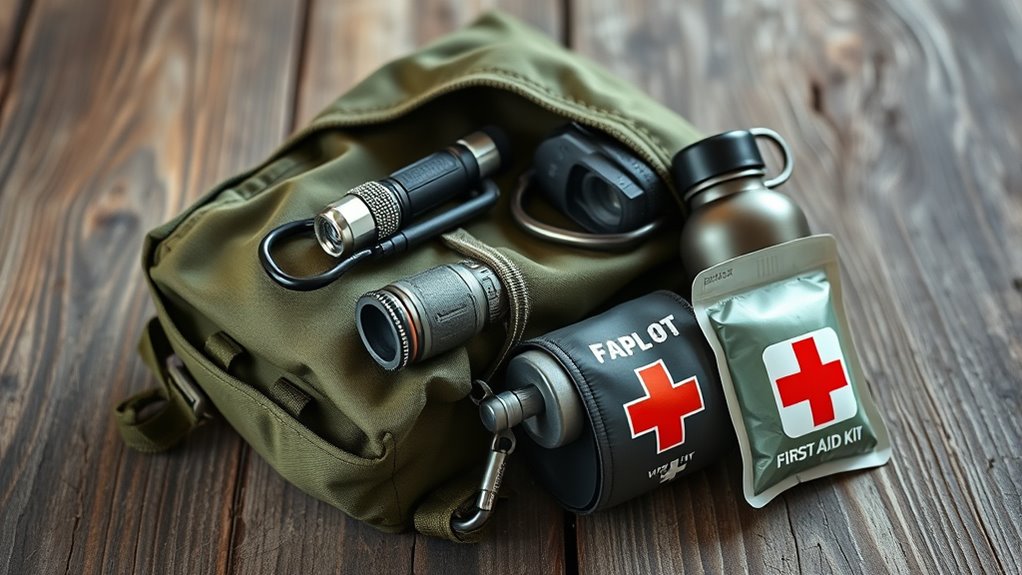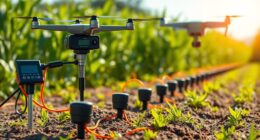For homesteaders, your bug out bag should include reliable emergency communication tools like battery-powered radios, extra batteries, and a whistle, so you stay informed and connected. Pack water purification supplies such as portable filters and tablets, along with knowledge of local water sources. Also, add portable chargers and durable gear you can quickly access and use. Staying prepared helps you handle crises smoothly—keep exploring to discover even more essential items for your survival kit.
Key Takeaways
- Include reliable communication tools like battery or hand-crank radios, with extra batteries and whistles for signaling.
- Pack water purification devices such as portable filters, purification tablets, and durable bottles for safe drinking water.
- Carry versatile, lightweight gear that serves multiple purposes, including emergency lighting, tools, and basic first aid supplies.
- Practice setting up and testing your communication and water purification equipment regularly to ensure readiness.
- Incorporate homesteading skills and familiarity with local water sources to adapt purification methods effectively during crises.

When preparing for emergencies, having a well-stocked bug out bag can make all the difference in your safety and survival. As a homesteader, you understand the importance of being ready for unexpected events, whether natural disasters or other crises. One key aspect is making sure you can maintain effective emergency communication. You need reliable ways to stay connected with loved ones, emergency services, or community members. Compact, battery-powered radios or hand-crank radios are essential, especially when power and cell networks are down. Including a portable charger or solar-powered power bank can keep your devices operational longer. Don’t forget extra batteries for your radio and flashlights, and consider a whistle for signaling in case of separation or distress. Clear communication can prevent confusion and help coordinate rescue efforts, making it a crucial component of your bug out plan. Additionally, understanding the importance of emergency preparedness can help you better anticipate potential challenges and respond more effectively in a crisis.
Along with communication tools, water purification methods are essential. Water is life, and during a crisis, clean drinking water might become scarce or contaminated. You should carry versatile water purification supplies, such as portable filters, purification tablets, or a small, durable water purifier bottle. These tools allow you to treat water from natural sources like streams, lakes, or rain collection systems. Understanding the different water purification methods ensures you can adapt to various situations. For example, chemical tablets are lightweight and effective for quick treatment, but they take time to work. Portable filters, on the other hand, can provide faster, continuous access to safe water and remove bacteria and protozoa. If you have a reliable water purifier, it can greatly extend your water supply and reduce the risk of waterborne illnesses. Remember, always have multiple methods on hand, as relying on a single water purification approach can be risky if that method fails or runs out. Developing cultural intelligence about local water sources and potential contaminants can further enhance your water treatment strategies in unfamiliar environments. Recognizing spoiled water indicators such as color, smell, or sediment can help you identify unsafe water sources more effectively. Incorporating knowledge about technology advancements can further improve your water purification efficiency and reliability. Being familiar with various water treatment options allows you to choose the most effective method based on your circumstances. Integrating emergency communication and water purification into your bug out bag isn’t just about having the right gear—it’s about understanding how to use it effectively. Practice setting up your radio and testing your water purification methods regularly. Familiarity with your supplies ensures you’re ready to act swiftly during a crisis. Your homesteading skills give you an advantage, but having the right tools and knowing how to use them is what will truly keep you safe. Prioritize lightweight, durable, and versatile items that can serve multiple purposes. This way, your bug out bag remains manageable but extensive enough to meet your needs when every second counts. Staying prepared with these essentials will give you confidence and peace of mind, knowing you’re ready to face emergencies head-on.
Frequently Asked Questions
How Do I Customize My Bug Out Bag for Different Seasons?
To customize your bug out bag for different seasons, start by packing seasonal clothing suited for hot or cold weather. Include layers, waterproof gear, and heat sources as needed. Also, make certain you have reliable water purification tools to stay hydrated regardless of the season. Adjust your supplies regularly based on changing weather conditions, and keep your bag lightweight yet thorough to handle any climate effectively.
What Are the Best Lightweight Tools for Homesteaders?
When choosing lightweight tools, you’re seeking a harmonious blend of efficiency and ease. Focus on compact gear that doesn’t weigh you down, like multi-use tools that serve multiple purposes in one device. These versatile options help you stay prepared without sacrificing mobility, making them ideal for homesteaders. With the right selection, you’ll find yourself ready to handle various tasks smoothly, all while keeping your pack light and manageable.
How Often Should I Update or Review My Bug Out Bag Contents?
You should review your bug out bag contents at least every six months to make certain bag maintenance and emergency preparedness. Regularly checking for expired items, damaged gear, or outdated supplies helps you stay ready for unexpected situations. Change seasonal clothing or tools as needed, and keep a record of any updates. Staying proactive ensures your bag remains effective and reliable when you need it most, giving you peace of mind.
Are There Specific Items Recommended for Long-Term Survival?
For long-term survival, you should include items like long-term food storage, such as freeze-dried foods or grains, that last years. Guarantee you have sustainable water sources like water purification tablets, filters, or a small solar still. Also, pack durable tools, first aid supplies, and emergency blankets. These essentials help you stay self-sufficient over extended periods, giving you peace of mind and better chances in a crisis.
How Can I Discreetly Carry My Bug Out Bag on the Homestead?
To discreetly carry your bug out bag on the homestead, focus on clever concealment and stealth storage. Use a concealed carry approach by selecting a lightweight, inconspicuous pack that blends with your daily gear. Opt for stealth storage solutions like hidden compartments or camouflaged bags. This way, you maintain mobility and minimize attention, making your essential equipment easily accessible while keeping your homestead secure and your readiness discreet.
Conclusion
So, now you’re all set with your bug out bag, ready to face the apocalypse—or just a really bad traffic jam. Remember, it’s not about having everything, but having enough to pretend you’re prepared. Keep it light, keep it handy, and maybe toss in a snack—because even homesteaders need a break from the chaos. Stay savvy, stay safe, and try not to forget where you buried your emergency stash!










